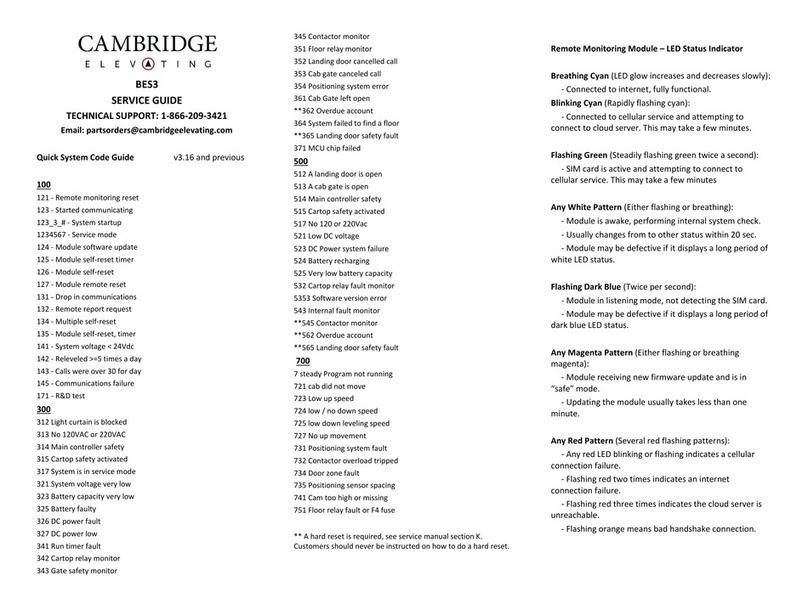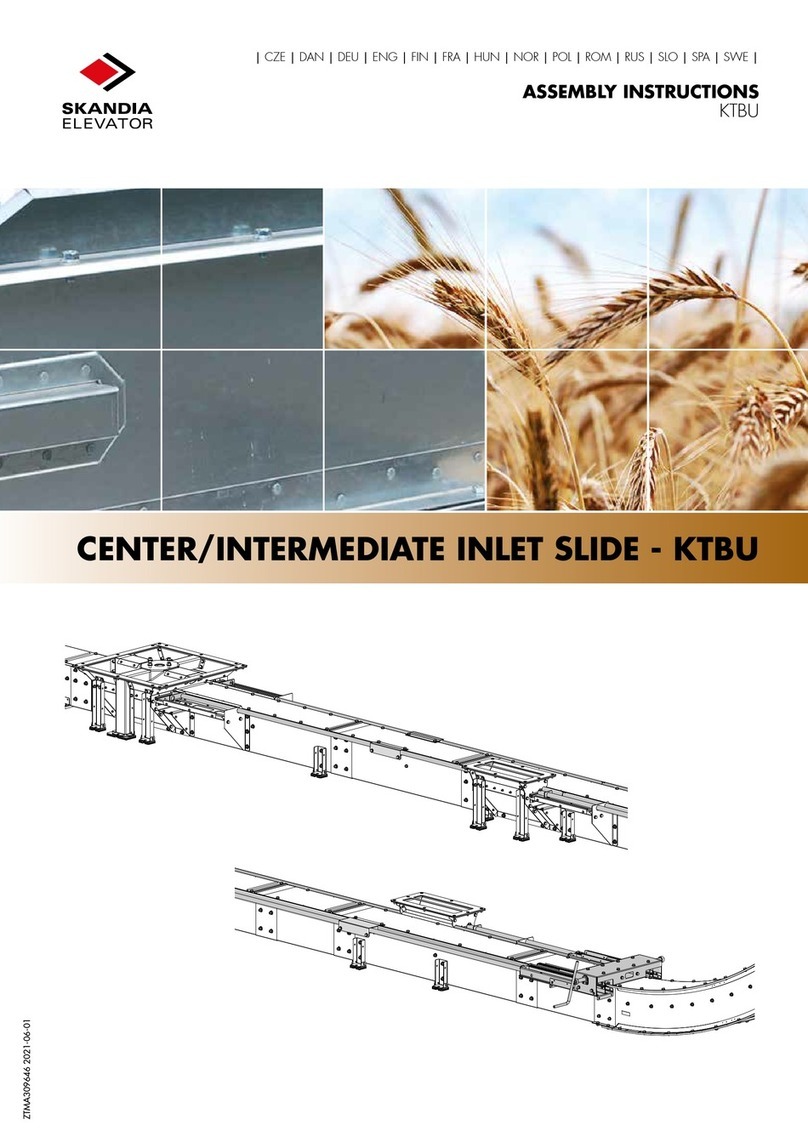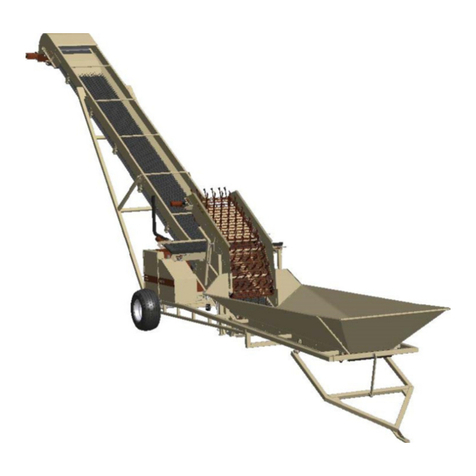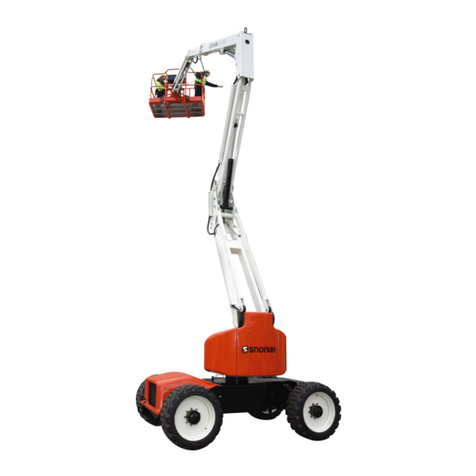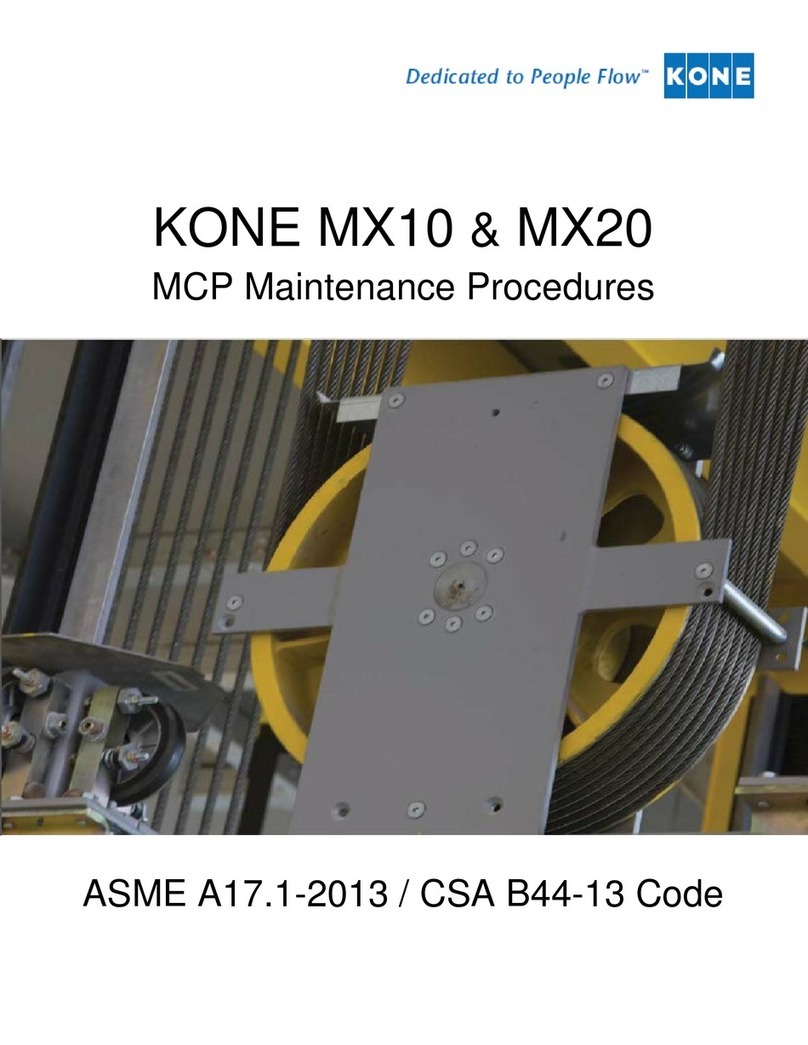FlexLink 5995512 User manual

Created by EBCCW 96:05Created by EBCCW 00:06Created by EBCCW 96:05Created by EBCCW 00:06
Spiral Elevator
C
r
eated by EBCCW 00:06
5478EN-3
Type 5995512
User Manual
Original Instructions 2011

Created by EBCCW 96:05Created by EBCCW 00:06

Created by EBCCW 00:06
Spiral Elevator
5478EN-3
© Flexlink Components AB 2010
All Rights Reserved
No part of this program and manual may be used, reproduced, stored or
transmitted in any form or by any means without the written permission of
FlexLink Components AB. The contents of this manual are for informational
use only. All information and specifications contained in this document
have been carefully checked to the best efforts of FlexLink Components
AB, and are believed to be true and accurate as of time of publishing.
However, due to continued efforts in product development FlexLink
Components AB reserves the right to modify products and its manuals
without notice.
FlexLink Components AB assumes no responsibility or liability on any
errors or inaccuracies in this program or documentation. Any kind of
material damages or other indirect consequences resulting from any
FlexLink Components AB product part, documentation discrepancies and
errors or non-anticipated program behavior are limited to the value of
appropriate products purchased from FlexLink Components AB. The
products are delivered to the customer at the ’as is’ state and revision level
they are on the moment of purchasing, and are declared in detail in the
license agreements between FlexLink Components AB and user. User
accepts and is obliged to follow the guidelines stated in the separate
license agreement needed in using any parts of this product package.
User Manual

5478EN-3

Created by EBCCW 00:06
Page I of II
5478EN-3
Content
1 Safety....................................................... 3
1.1 System information.................................. 3
1.2 The most important safety conditions...... 4
1.3 Description of safety provisions............... 5
1.4 Safety measures to be taken .................... 6
1.5 Explanation of symbols ............................ 7
2 Technical specifications............................ 8
2.1 Technical data........................................... 9
2.2 Ordering information.............................. 10
2.3 Operating conditions .............................. 11
3 Introduction ........................................... 12
3.1 Purpose of use ....................................... 12
3.2 Description of the Spiral Elevator ........... 13
3.3 Working principle................................... 19
3.4 Control units .......................................... 21
4 Unload the Spiral Elevator ...................... 22
4.1 Preparation............................................. 22
4.2 Unloading instructions ........................... 23
5 Mounting, installation, adjustment ......... 27
5.1 Provisions to be provided ...................... 27
5.2 Assembly ................................................29
5.3 Validation ................................................33
5.4 Integration in a (transport) system .........35
5.5 Setting of the Spiral Elevator...................37
5.6 Test run - partially loaded........................39
6 Technical maintenance............................43
6.1 Check and control procedures ................43
6.2 Maintenance procedures.........................47
6.3 Troubleshooting list ................................57
6.4 Maintenance schedule Spiral Elevator.....60
7 Put out of commission............................62
7.1 Disconnect the power sources................62
7.2 Disassemble............................................62
7.3 Transport ................................................63
7.4 Disposal..................................................64
7.5 Reuse......................................................64
8 Spare parts list........................................65
8.1 Spiral Elevator 5995512..........................65
9 Supplier’s information.............................66
10 Manufacturer’s declaration......................67

Page II of II 5478EN-3

Created by EBCCW 00:06
Page 1 of 68
5478EN-3
Preface
Purpose of this manual
The purpose of this manual is to describe various operations that are
intended for the user to perform.
This document contains remarks that point out a risky or specific situation
to the user. In many cases this situation is provided with one of the symbols
given below.
Compliance with the operations described in this document is important in
order to prevent dangerous situations and unnecessary damage to
the Spiral Elevator
It is recommended to keep one copy of this manual near the machine and
one copy with your technical documentation.
Structure of the manual
The user's manual has been composed in such a way, that a number
of operations can quickly and easily be found.
This manual does not describe operations that are not intended for the user
to perform.
The user's manual has been divided into sections which describe a variety
of functions including the safety and the safe operation of the
Spiral Elevator.
It is recommended that this manual is read by all users of this equipment
with particular reference to Section 1 on page 3: Safety.
.
General warning for danger!
.
Warning for electrical voltage!
.
Attention, this is an important notice!

Page 2 of 68 5478EN-3
Requirements of the user
The Spiral Elevator should only be operated by a person who has become
acquainted with section 1 'safety' and trained in the use of the unit.
The Spiral Elevator should only be installed by persons who have become
acquainted with section 4 'unload the Spiral Elevator.
. Note! Maintenance activities on the Spiral Elevator should only
be carried out by a technically qualified person.
. Note! Technically qualified employees means: persons that have
received adequate training for carrying out the activities involved.

Safety
Created by EBCCW 00:06
Page 3 of 68
5478EN-3
1 Safety
The Spiral Elevator has been designed such, that it can be used and
maintained in a safe way. This holds for the application, the circumstances
and the instructions described in the manual. Any person working with or
on this machine should study and follow the instructions contained within
this manual.
The company or the country in which the machine is used may require
extra safety measures. This particularly applies to the working conditions.
This manual does not describe how these are to be complied with. In case
of doubt, consult your government or safety officer!
1.1 System information
The project number and/or general drawing number (identification number)
shall always be specified when communicating with FlexLink with respect
to the Spiral Elevator.
The following detail plates are generally attached to the Spiral Elevator.
Figure 1 Example of Machine plate (system supplier)
Figure 2 Spiral Elevator plate ( Manufacturer)

Safety
Page 4 of 68 5478EN-3
1.2 The most important safety conditions
Before the Spiral Elevator is put in to service, the following safety
conditions must be met:
• Provide good ambient lighting.
• Equipment users should have read and understood the operating
instructions to operate, maintain or clean the machine.
• Equipment users should not reach into the machine while it is
running. Even if the machine is not running, it may be 'on', which
means it may start operating automatically.
• Safety provisions (where fitted), such as side plating, bottom
plating, emergency stops and detectors must not be removed or
deactivated while the Spiral Elevator is running.
• Before clearing of any jams, the unit should be stopped and safely
isolated.

Safety
Created by EBCCW 00:06
Page 5 of 68
5478EN-3
1.3 Description of safety provisions
As a standard the Spiral Elevator is not provided with control or any safety
provisions. Before putting the Spiral Elevator into service some safety
provisions are to be incorporated. The purpose of these safety provisions
is to protect the user, the product and the Spiral Elevator against undesired
situations (damage). If these safety provisions are not incorporated it will
invalidate the warranty.
The table below gives a general description of the safety provisions
required. Only technically qualified persons should work on the settings of
the safety provisions!
The safety provisions listed in the table are a general guide only. The actual
safety provisions to be used must be determined by relevant risk
assessment of the overall system.
Where the possibility exists for oversize product to enter the Spiral Elevator
it is recommended to install a detector prior to the Spiral Elevator and use
this to stop the elevator thus preventing damage from occurring.
Note! If an oversize product jams in the Spiral Elevator it may
damage the unit.
Control Remark
Emergency stop switch Each Spiral Elevator is to be provided with one or more emergency stop
switches that can be operated within reach of the user. The emergency
stop switch must make sure that the input and output conveyors or
machines are switched off simultaneously.
Motor protection The technical specification of the Spiral Elevator is, among other things,
geared to the load given in the technical specification, quotation or
drawing.
Should the Spiral Elevator (gear motor) become overloaded, this should be
detected by the motor protection in the control system. Without this
protection there is a chance that the gear motor or other components of the
Spiral Elevator will be damaged and this damage will not be covered by the
warranty.
Motor isolation Means of isolating the motor from the power supply must be provided and
within close proximity to the motor.

Safety
Page 6 of 68 5478EN-3
. Note! Only technically qualified persons are allowed to change
the settings of the safety provisions.
1.4 Safety measures to be taken
For a safe operation of the Spiral Elevator a number of safety measures are
to be taken. These include the following measures:
• Clean floor surface - With a clean floor surface the operator will
not be hindered while operating the Spiral Elevator. This can
prevent tripping or slipping, so that the operator does not
unexpectedly come into contact with the Spiral Elevator.
• Hearing protection -Different tests have shown that the
Spiral Elevator does not produce more than 85dB(A)
Mechanical Remark
Height / width
detector
Product entering the Spiral Elevator should not be of a size where the product
can become jammed in the Spiral Elevator.
In order to ensure that product cannot become jammed in the Spiral Elevator
due to oversize some automatic checks for width and height can be done.
This detection must take place before the Spiral Elevator in order to stop the
product or Spiral Elevator.
The maximum dimensions of the product are given in the technical
specification, quotation or drawing.
Transition guard The basic Spiral Elevator is not supplied with any guarding at the drive / idler
ends. A risk assessment should be conducted with consideration to the
adjacent conveyors/equipment product etc. to establish any requirements for
guarding.

Safety
Created by EBCCW 00:06
Page 7 of 68
5478EN-3
1.5 Explanation of symbols
Pictogram symbols have been placed on the Spiral Elevator in order to
identify to the user certain conditions or provide certain information on
components of the Spiral Elevator.
No. Description Picture
1.Spiral Elevator plate This contains the name and the
address of the initial
manufacturer, series or type
indication, serial number and the
year of construction of the Spiral
Elevator.
2.Gear motor plate This contains information of the
gear motor supplier along with the
CE-mark if appropriate. Also
indicated is the gear motor type,
applicable voltages, power, oil
type etc.
3. Machine plate This contains the system supplier,
installation date and the
Identification Number of the Spiral
Elevator and information of the
system supplier along with the
CE-mark if appropriate.
Example of Gear motor plate
Example of Machine plate

Technical specifications
Page 8 of 68 5478EN-3
2 Technical specifications
Below is the technical specification of the Spiral Elevator.
Further product details to which the Spiral Elevator has been designed are
contained within the overall Project Documentation (when purchased as
part of a Project System).
Use of the Spiral Elevator outside of the scope detailed within the technical
specification, quotation or documentation will invalidate the warranty.
General FlexLink Spiral Elevator specification
• 500 mm inclination per winding (9 degree)
• 3-8 windings
• 1000 mm nominal centreline diameter
• Speed 5 - 60 metres per minute
• Lower height:- 600, 700, 800, 900 or 1000 mm
- Adjustable -50/+70 mm
• Max load 10 Kg/m (specific Spiral Elevators may be with a lower
limit due to actual gear motor used)
• Product size:
- width= 50 - 200 mm
- length= 80 - 250 mm
- height= 1,5 x Length (max 300 mm)
- see Project Documentation if applicable
• Drive and idler ends are horizontal
• Chain width 100 mm
• Friction top chain
• Steel chain with bearings running on the inner guide rail
• Wet coated mild steel frame
• Column diameter 160 mm
• M8 thread for guide rail

Technical specifications
Created by EBCCW 00:06
Page 9 of 68
5478EN-3
2.1 Technical data
350
815
985
1000
n159
5°
8x45°
500 mm
(inclination)
Lower height
600/700/800/900/1000 mm -50/+70
Machine incl.
adjustable feet
5000 mm
(Max. heigth
8 windings)
AB
In/ Out Feed Configurations

Technical specifications
Page 10 of 68 5478EN-3
2.2 Ordering information
Example of a Spiral Elevator designation obtained from the FlexLink
product configurator:
5995512- Item number
A Chain width
B Spiral center of chain diameter
C Incline per winding
D Mild steel (S) material configuration
E Configuration A or B
F Transport direction up/down TU or TD
G Lower height 600/700/800/900/1000
H Number of windings 3,4,5,6,7,8
I Shaft diameter 20 mm (for gear motor type SA37) or 25 mm (for
gear motor type SA47)
For more information please contact your local FlexLink office.
Item no A B C D E F G H I
5995512 100 -1000 -500 - S - A -TU -800 - 3 - 25

Technical specifications
Created by EBCCW 00:06
Page 11 of 68
5478EN-3
2.3 Operating conditions
The circumstances under which the Spiral Elevator can be operated partly
depend on the materials selected. FlexLink has defined a number of
parameters within which the Spiral Elevator would be allowed to function.
Should the Spiral Elevator still be operated beyond these limiting values,
FlexLink cannot guarantee the good functioning of the Spiral Elevator.
As a standard no lighting is installed on the Spiral Elevator although this
can not be added as an option. Normal ambient lighting is sufficient to work
safely with the Spiral Elevator. The Spiral Elevator is not intended for use
in an open air environment or in an area with a risk of explosion, although
static safe materials are available.
If in doubt of the suitability FlexLink should be consulted.
Ambient temperature (in operation) 0 to +35°C
During transport / storage 5 to +40°C
Relative air humidity (RH) 30% to 95%, not condensing
Lighting Normal ambient lighting
Height Up to max. 2000 m above sea
level

Introduction
Page 12 of 68 5478EN-3
3 Introduction
This section deals with a number of general matters with respect to
the Spiral Elevator. This involves, among other things, the purpose of use,
the conditions of use and the working principle of the Spiral Elevator.
Should you have any further questions on the safe operation of the
Spiral Elevator please contact FlexLink.
The warranty conditions have been included in the FlexLink quotation or
are available separately from FlexLink.
FlexLink does not accept any liability for unsafe situations, accidents and
damages resulting from:
• Neglect of warnings or stipulations as displayed on the machine,
in this documentation or in the Project Documentation
(if applicable).
• Use in applications or circumstances other than those specified in
this manual, the quotation, the Project documentation
(if applicable), or FlexLink catalogue.
• Modifications to the machine. This also includes the use of
replacement parts other than those specified and supplied by
FlexLink.
• Insufficient or incorrect maintenance.
FlexLink does not accept any liability for the consequential damage in case
of failures of the machine, for example damage of products, interruption of
operation, etc.
3.1 Purpose of use
The purpose of use of the Spiral Elevator is to transport products / goods
in a vertical direction. This may be for bridging a difference in height or for
functioning as a cooling buffer.
It is not recommended to use the Spiral Elevator for transporting products
with parts that are protruding, hanging loose, for transporting products that
result in a higher load than mentioned in the documentation or for
transporting products with measurements deviating from those given in the
technical specification associated with the particular Spiral Elevator.
Additionally it is not permitted to walk, stand or sit on the Spiral Elevator or
to stick objects or body parts between the guards, conveyor plates or other
moving parts.

Introduction
Created by EBCCW 00:06
Page 13 of 68
5478EN-3
3.2 Description of the Spiral Elevator
The Spiral Elevator is applied in a (transport) system where products can
be transported vertically in a relatively small area. The Spiral Elevator can
be coupled to other transport systems and be built according to the
customer's needs.
Figure 3 Principle sketch (Transport direction up) / Configuration options
Before the Spiral Elevator is put in to service a suitable Risk Assessment
should be completed.
After integration / installation the Spiral Elevator should not be relocated
without further Risk Assessment
AB

Introduction
Page 14 of 68 5478EN-3
Configuration input / output
The configuration of the Spiral Elevator is available in different formats with
regard to input / output positions. These configuration types are expressed
in the letters A or B.
It is possible to have a configuration with which the output side is placed at
a different angle. For any special configurations please contact FlexLink.
Dimensions of the Spiral Elevator
The height of the Spiral Elevator is dependant upon the low level height
plus the number of turns of the spiral (see Technical Specification - Section
2 on page 8).
AB
Table of contents
